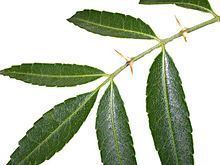Rank Species | ||
 | ||
Similar Schinopsis haenkeana, Zanthoxylum coriaceum, Ruprechtia apetala, Zanthoxylum kauaense, Zanthoxylum hawaiiense | ||
Zanthoxylum coco (also known as Fagara coco) is an evergreen tree of the Rutaceae family, natural of Argentina and Bolivia where it grows in the wild, mostly hilly, spinniferous forests. Its natural habitat ranges the hilly forest of Sierras Pampeanas.
Contents
Description
The coco, also cochucho or smelly sauco, is usually found either in isolated groups or standing alone, from a small to medium sized tree, ranging 6 to 8 metres in height . The foliage is abundant, evergreen with imparipinnate leaves that present paired spines presumably in the place of leaflets. Punctations, in pairs, on the leaflets are quite distinctive. Leaves have serrated margins and pinnate venation. Flowers have five petals and are arranged in panicular inflorescences. The fruit is spherically shaped, dehiscent; containing a shiny blackish seed. The whole plant has a characteristic unpleasant smell, hence the alternative name "smelly sauco".
Biochemistry
Even though unused in general botanical pharmacopea, Zanthoxylum coco tissues are very rich in alkaloids. Fagarine, N-methylisocoridine, eskimminianine, α-fagarine, fagarine-2, magnoflorinne, nitidine, cheleritrinne, berberine, palmatine and candicine have been isolated from foliage and wood.
Taxon synonym usage
The coco belongs to the Zanthoxylum genus. However, most local scientific articles use Fagara as the genus of choice.
